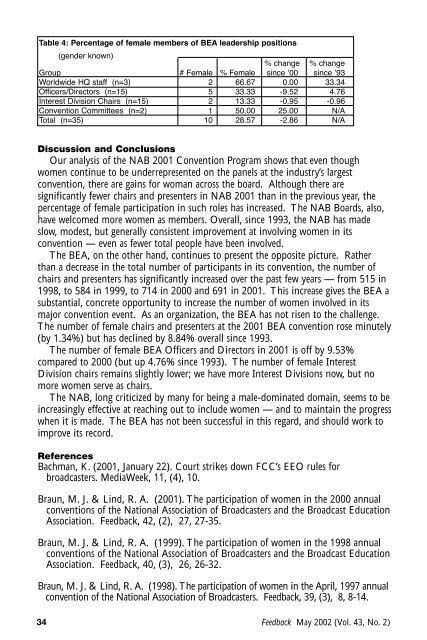Feedback May 2002 (Vol 43 No 2)
Feedback May 2002 (Vol. 43, No. 2) - Broadcast Education ...
Feedback May 2002 (Vol. 43, No. 2) - Broadcast Education ...
- No tags were found...
You also want an ePaper? Increase the reach of your titles
YUMPU automatically turns print PDFs into web optimized ePapers that Google loves.
Table 4: Percentage of female members of BEA leadership positions(gender known)% change % changeGroup # Female % Female since ’00 since ’93Worldwide HQ staff (n=3) 2 66.670.00 33.34Officers/Directors (n=15) 5 33.33 -9.52 4.76Interest Division Chairs (n=15) 2 13.33 -0.95 -0.96Convention Committees (n=2) 1 50.00 25.00 N/ATotal (n=35) 10 28.57-2.86 N/ADiscussion and ConclusionsOur analysis of the NAB 2001 Convention Program shows that even thoughwomen continue to be underrepresented on the panels at the industry’s largestconvention, there are gains for woman across the board. Although there aresignificantly fewer chairs and presenters in NAB 2001 than in the previous year, thepercentage of female participation in such roles has increased. The NAB Boards, also,have welcomed more women as members. Overall, since 1993, the NAB has madeslow, modest, but generally consistent improvement at involving women in itsconvention — even as fewer total people have been involved.The BEA, on the other hand, continues to present the opposite picture. Ratherthan a decrease in the total number of participants in its convention, the number ofchairs and presenters has significantly increased over the past few years — from 515 in1998, to 584 in 1999, to 714 in 2000 and 691 in 2001. This increase gives the BEA asubstantial, concrete opportunity to increase the number of women involved in itsmajor convention event. As an organization, the BEA has not risen to the challenge.The number of female chairs and presenters at the 2001 BEA convention rose minutely(by 1.34%) but has declined by 8.84% overall since 1993.The number of female BEA Officers and Directors in 2001 is off by 9.53%compared to 2000 (but up 4.76% since 1993). The number of female InterestDivision chairs remains slightly lower; we have more Interest Divisions now, but nomore women serve as chairs.The NAB, long criticized by many for being a male-dominated domain, seems to beincreasingly effective at reaching out to include women — and to maintain the progresswhen it is made. The BEA has not been successful in this regard, and should work toimprove its record.ReferencesBachman, K. (2001, January 22). Court strikes down FCC’s EEO rules forbroadcasters. MediaWeek, 11, (4), 10.Braun, M. J. & Lind, R. A. (2001). The participation of women in the 2000 annualconventions of the National Association of Broadcasters and the Broadcast EducationAssociation. <strong>Feedback</strong>, 42, (2), 27, 27-35.Braun, M. J. & Lind, R. A. (1999). The participation of women in the 1998 annualconventions of the National Association of Broadcasters and the Broadcast EducationAssociation. <strong>Feedback</strong>, 40, (3), 26, 26-32.Braun, M. J. & Lind, R. A. (1998). The participation of women in the April, 1997 annualconvention of the National Association of Broadcasters. <strong>Feedback</strong>, 39, (3), 8, 8-14.34<strong>Feedback</strong> <strong>May</strong> <strong>2002</strong> (<strong>Vol</strong>. <strong>43</strong>, <strong>No</strong>. 2)
















